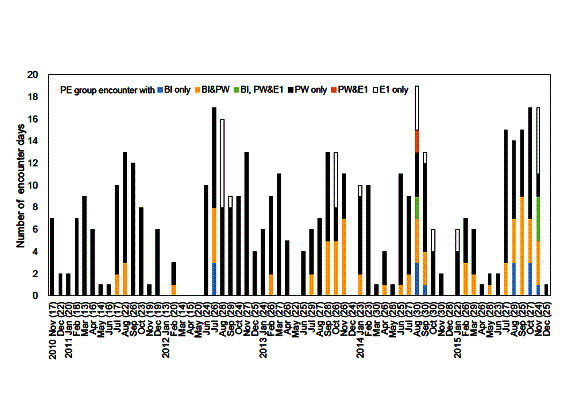



|
TOPICS BONOBO Chimpanzee "Ai" Crania photos Itani Jun'ichiro archives Open datasets for behavioral analysis Guidelines for Care and Use of Nonhuman Primates(pdf) Study material catalogue/database Guideline for field research of non-human primates 2019(pdf) Primate Genome DB 
Primate Research Institute, Kyoto University Copyright (c) |
Japanese Increased frequency of intergroup encounters in wild bonobos (Pan
paniscus) around the yearly peak in fruit abundance at Wamba.
Sakamaki T, Ryu H, Toda K, Tokuyama N, and Furuichi.
Abstract
Intergroup interactions in primates vary from nonagonistic to severely aggressive. Food resources and fertile females cause intergroup aggression when groups defend resources and mates from other groups. Peaceful intermingling during intergroup encounters is rare but has been reported in several primates, including bonobos (Pan paniscus). Although intergroup encounters in bonobos occur at both nonprovisioned and provisioned sites, provisioning may be one factor responsible for frequent intergroup encounters. We studied intergroup encounters between one bonobo group (PE) and its neighboring groups, one semihabituated and two habituated groups, under nonprovisioned conditions in 2010-2015 at Wamba, Democratic Republic of Congo. We examined whether fruit abundance and females with sexual swellings influenced encounter frequency. PE group encountered the other groups on 7.1 days (mean, range: 0-19) per month. Up to four different groups met simultaneously at one location. Encounter frequency was highest around the yearly peak in fruit abundance, suggesting that reduced food competition is linked to increased encounter frequency. During periods of relatively low fruit abundance, the probability of an encounter was higher when a higher number of adult females with maximum sexual swellings were present, suggesting that the attractiveness of females with sexual swellings promoted group encounters during periods of relatively low fruit abundance. These findings suggest that both competition for food and the availability of females with sexual swellings influence encounter frequency in bonobos.  Figure. Number of days on which intergroup encounters occurred between PE group and other groups (PW, BI, and E1) of bonobos
at Wamba in the northern sector of Luo Scientific Reserve, Democratic Republic of Congo, each month in November 2010-December 2015. Numbers in parentheses indicate the number of observation days. Bibliographic information
International Journal of Primatology pp 1-20 2018/09/25 Primate Research Institute
|